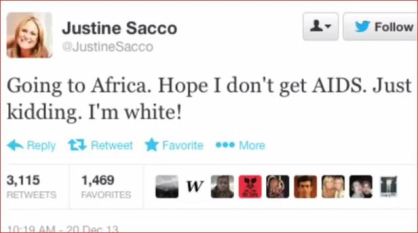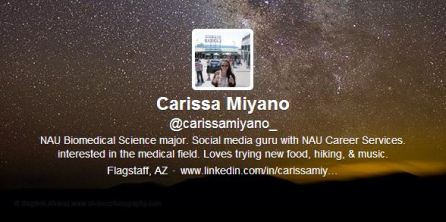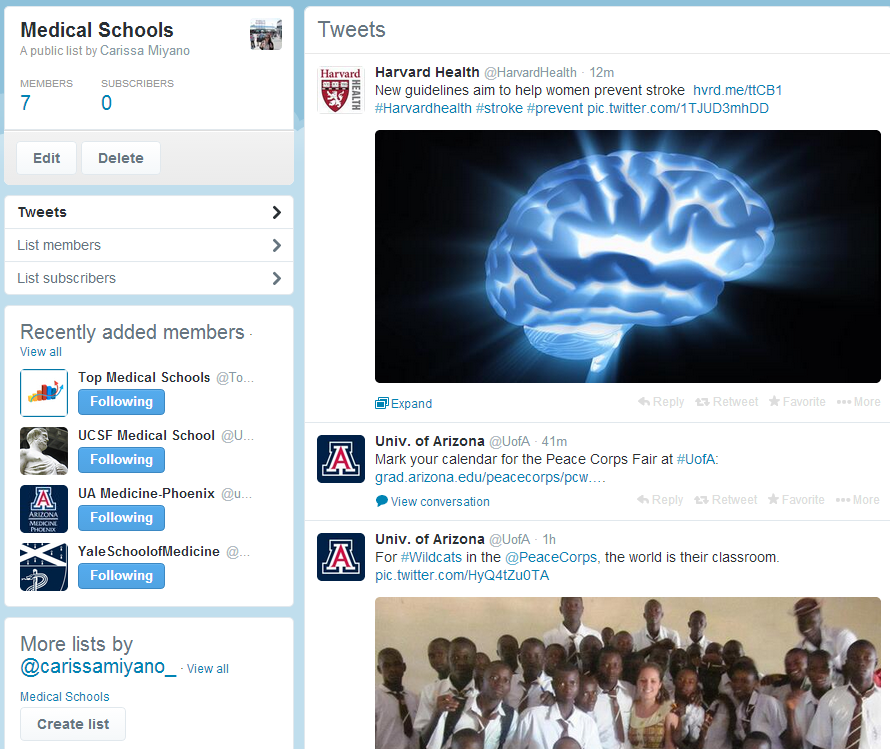We have all seen the dangers that can arise from uncensored use of social media, particularly when Justine Sacco, former PR executive at IAC carelessly tweeted this before hopping on a plane to South Africa:
After a huge amount of outrage and backlash, Sacco was fired. Don’t worry, I’m not here to scare you- I want to teach you how to be a “superhero” and use social media for good- after all, 37% of companies use social media to research candidates and 94% of recruiters use social media to recruit potential candidates. Your goal shouldn’t be to erase any online presence or Google results you may have, but to create a positive and powerful online presence through the use of one of the most popular and public social media outlets: Twitter.
What is Twitter? Twitter is a social media site and app that allows you to create a “tweet” in 140 characters or less. Your tweets go out to your followers and anybody that views your profile- which is why you want to make your tweets meaningful and to “think before you tweet.” Using Twitter professionally allows you to follow an industry including companies you are interested in and their related news. While you can certainly use Twitter to get a job with their company, I’m here to help you utilize this site to your professional advantage.
How to get started
1. Create an account
Download the app or go to the website, twitter.com. Create an account and start filling out your profile. It will ask you to choose a username. I would suggest doing something that people could recognize you by, like choosing @your_name or something similar.
2. Fill out your profile
It is important that you create an effective biography because this is someone’s first impression of you! A great twitter biography would state what you do, your goals, and, perhaps, a hobby. Here’s an example:
“NAU English Major hoping to become a freelance writer. Loves photography, 90s music, and hiking.”
Don’t forget to also fill out your website and location. This is an excellent place to put your LinkedIn URL! If you haven’t made your LinkedIn profile yet, refer to my how-to blog post here. Last but not least, upload a profile picture and a cover photo. Keep your cleavage-baring and beer chugging pictures for your private album. A nice headshot would be perfect! Your profile should kind of be like a “business card.” Here is an example of what your twitter “business card” can look like:
3. Follow away!
Find companies, industries, and people to follow. Follow based on your interests and their tweets! After you follow users, Twitter will suggest users for you to follow. You can also create lists to organize who you follow. If you would like to only see the timeline of profiles, for example, in medical healthcare, you can organize them all into a list.
4. Start tweeting.
Follow my golden rule: if you wouldn’t want your grandma to see it, don’t tweet it. Keep it professional. Good ideas for tweets could include links to intriguing news articles, the latest news on your class projects, volunteer experiences, personal successes, and even your favorite band! You don’t have to keep it completely professional – feel free to let your twitter followers get to know YOU. Tweet about your hobbies or an awesome new biking trail you found. To learn how to network and engage other users, read this Mashable article.
5. Research and follow relevant hashtags.
Hashtags are words with the hashtag symbol (#) before them, like this: #naucareer. For example, if you want to look up Jobs of the Day that have been posted by career twitter users (including our own @naucareer), you can search #JobOfTheDay and view all the tweets that have been tweeted using #JobOfTheDay.
Hashtags are a great way to get connected and join conversations of trending topics. If you would like to join in on a topic, use the hashtag so it will appear in search results. Here are a few suggestions to start you off: #jobtips #joblisting #jobhuntchat #recruiting #jobsearch #career #hiring #hireme #jobangels #jobopening and, of course, #naucareer!
While professional use of twitter is unlikely to replace your resume, it is helpful to be more “discoverable” through your online presence. Instead of avoiding an online presence, aim for positive search results. You want recruiters to find you, so get started intentionally creating a professional digital identity!




One thought on “How to Become A Twitter Guru”